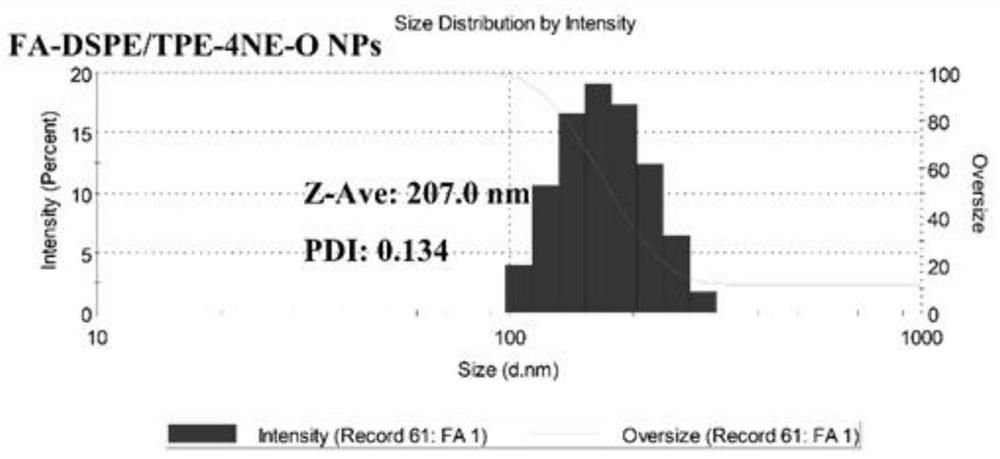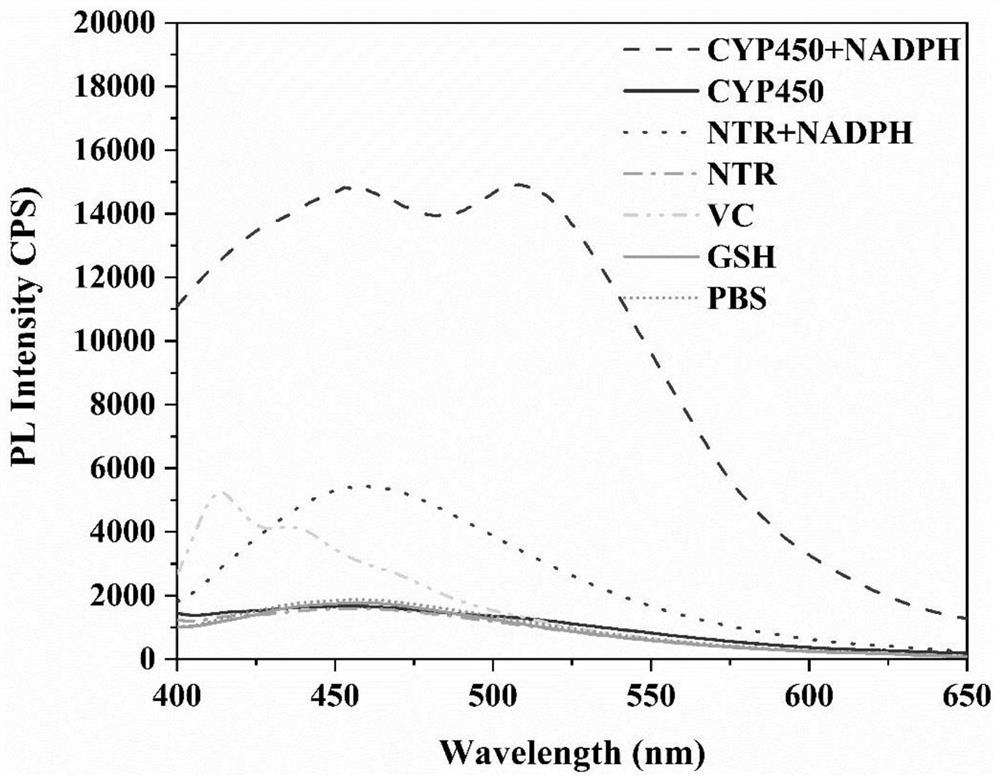Nanoprobe for detecting hypoxic cells and preparation method and uses of nanoprobe
A nanoprobe, TPE-4NE-O technology, applied in chemical instruments and methods, preparation of amino compounds from amines, preparations for in vivo tests, etc., can solve the problem of poor tumor penetration ability, complex synthesis steps, and poor water solubility. and other problems, to achieve the effect of simple and reliable preparation method, small polydispersity coefficient and uniform particle size
- Summary
- Abstract
- Description
- Claims
- Application Information
AI Technical Summary
Problems solved by technology
Method used
Image
Examples
Embodiment 1
[0054] Synthesis of embodiment 1 fluorescent probe molecule TPE-4NE-O:
[0055] Synthesis of TPE-4NE: Weigh 2.0g of bis(4-(diethylamino)phenyl)methanone and 1.21g of zinc powder in a double-neck flask, then vacuumize and fill with argon, add 50mL of anhydrous tetrahydrofuran, and After the solution was cooled to -20°C, slowly add 680 μL of titanium tetrachloride into the solution using a syringe, continue stirring for 30 minutes, transfer the solution to room temperature and continue stirring for 1 hour, then reflux and stir overnight, after the reaction solution cooled to room temperature, add 20mL 10%K 2 CO 3 Quench the reaction with an aqueous solution, remove insoluble matter by suction filtration, collect the filtrate, extract with dichloromethane three times, combine the organic layers, concentrate in vacuo, and separate by column chromatography to obtain TPE-4NE; 1 HNMR (300MHz, CDCl 3 ), δ(CDCl 3 ,ppm):7.24-6.16(m,16H),4.16-2.22(m,16H),1.15-1.09(m,24H).HRMS,m / z cal...
Embodiment 2
[0057] Embodiment 2 does not contain the preparation of the nanoprobe of PEG modification:
[0058] Weigh 5 mg of TPE-4NE-O and dissolve it in 5 mL of LPBS, stir at 400 rpm for 3 minutes, and then filter through a 0.45 μm microporous membrane to remove the aggregates in the solution to obtain the PEG-free nanoprobe solution TPE-4NE-O NPs were stored in a refrigerator at 4°C for later use.
[0059] The appearance and particle size distribution of the prepared nanoprobes (TPE-4NE-O NPs) were characterized by transmission electron microscopy. Transmission electron microscope pictures as figure 1 , the particle size of the prepared nanoprobes is about 50nm, and the appearance is regular spherical; the particle size is relatively consistent, indicating that the prepared nanoprobes have good uniformity.
Embodiment 3
[0060] Example 3 Preparation of DSPE-PEG-modified nanoprobes bonded with folic acid:
[0061] Weigh 5mg TPE-4NE-O and 1.5mg FA-DSPE-PEG respectively 2000 , dissolved them together in 5mL PBS, stirred at 400rpm for 3min, and then filtered through a 0.45μm microporous membrane to remove the aggregates in the solution to obtain the folic acid-bonded DSPE-PEG-modified nanoprobe FA-DSPE / TPE-4NE-O NPs, store it in a refrigerator at 4°C until use.
[0062] The appearance and particle size distribution of the prepared nanoparticles were characterized by transmission electron microscope and Malvern particle size analyzer. Transmission electron microscope pictures as figure 2 , the particle size of the prepared nanoprobe is about 200nm, and the appearance is regular spherical; the particle size distribution results are as follows image 3 , the hydrated particle size of nanoprobes presents a typical normal distribution, and the polydispersity coefficient is 0.134, indicating that t...
PUM
| Property | Measurement | Unit |
|---|---|---|
| Particle size | aaaaa | aaaaa |
| Particle size | aaaaa | aaaaa |
Abstract
Description
Claims
Application Information
 Login to View More
Login to View More - R&D
- Intellectual Property
- Life Sciences
- Materials
- Tech Scout
- Unparalleled Data Quality
- Higher Quality Content
- 60% Fewer Hallucinations
Browse by: Latest US Patents, China's latest patents, Technical Efficacy Thesaurus, Application Domain, Technology Topic, Popular Technical Reports.
© 2025 PatSnap. All rights reserved.Legal|Privacy policy|Modern Slavery Act Transparency Statement|Sitemap|About US| Contact US: help@patsnap.com



